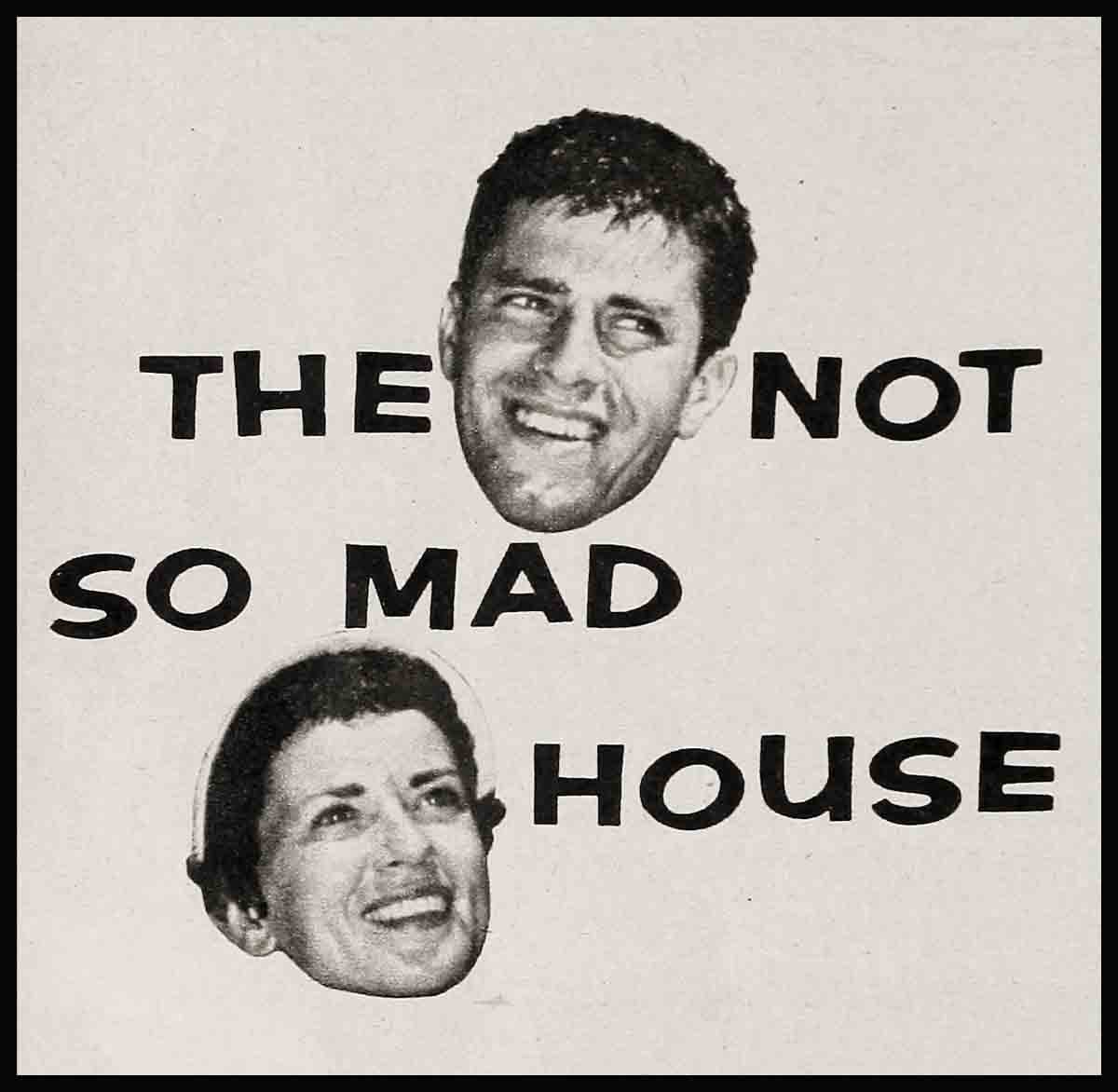
The Not So Mad House—Patti & Jerry Lewis
A week before those two irrepressible zanies, Martin and Lewis, were scheduled to appear at the Palladium in London, a British magazine flew one of its top writers across the Atlantic to interview Jerry.
After many fruitless expeditions all over Hollywood, the scribe finally located the rubber-faced, crew-cut comic in a sporting goods store. Jerry was trying on golf shoes.
“I’ll need an extra heavy shoe for those Scotch golf courses, don’t you think, old boy?” That was Lewis’ opening remark to the visiting Britisher.
“Why don’t you wait and buy a pair in London?” the reporter suggested.
“Ridiculous,” Jerry answered. “They’re cheaper there.” Then turning to the clerk, he said, “Do these shoes come in brown and white, too?”
Told that they did, the gangling screwball ordered identical pairs in black and white, cordovan, and Norwegian calf.
Next he tried on Bermuda-length shorts. They looked good to him so he bought an even dozen pairs in linen, flannel, and tropical worsted. Moving over to the camera department he ordered half a dozen reflectors and spotlights. “Need these for my camera work,” Jerry explained.
“But I thought Paramount provided that sort of equipment!” the flabbergasted Englishman managed to sputter.
Lewis crossed his eyes and drew an imaginary pistol from his belt, aiming his index finger at the reporter’s heart. “Say that one more time, you varmint,” he drawled, “and I’ll have you sent to the Tower. Do you hear me, you wretch?”
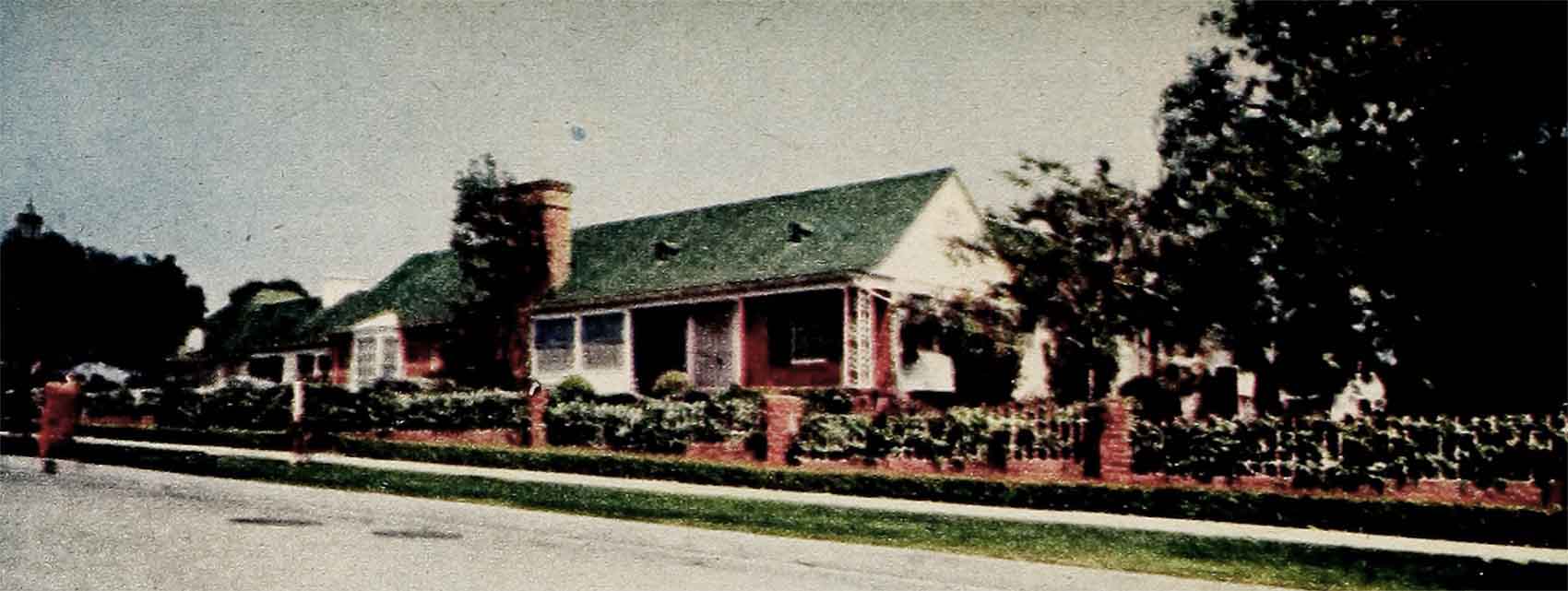
Unaccustomed to Jerry’s shenanigans, the British reporter scratched his head in amazement, whereupon Lewis moved up to him and said, “Look, Hyman, I thought I told you to wait outside and wash the car.”
Finished spending $800 in the sporting goods store, Jerry then raced across Wilshire Boulevard into a confectionary shop. Like a little boy with his allowance to spend, he eyed all the glass cases, finally settling for a pound of licorice, and bags of jelly beans, nuts, and assorted gum drops. “This bulk candy,” he observed, “gets stale very quickly.” He sampled a mouthful of jelly beans. “Now,” he said, “all we have to do is to stop at the framer’s and bookbinder’s—then we’re home.”
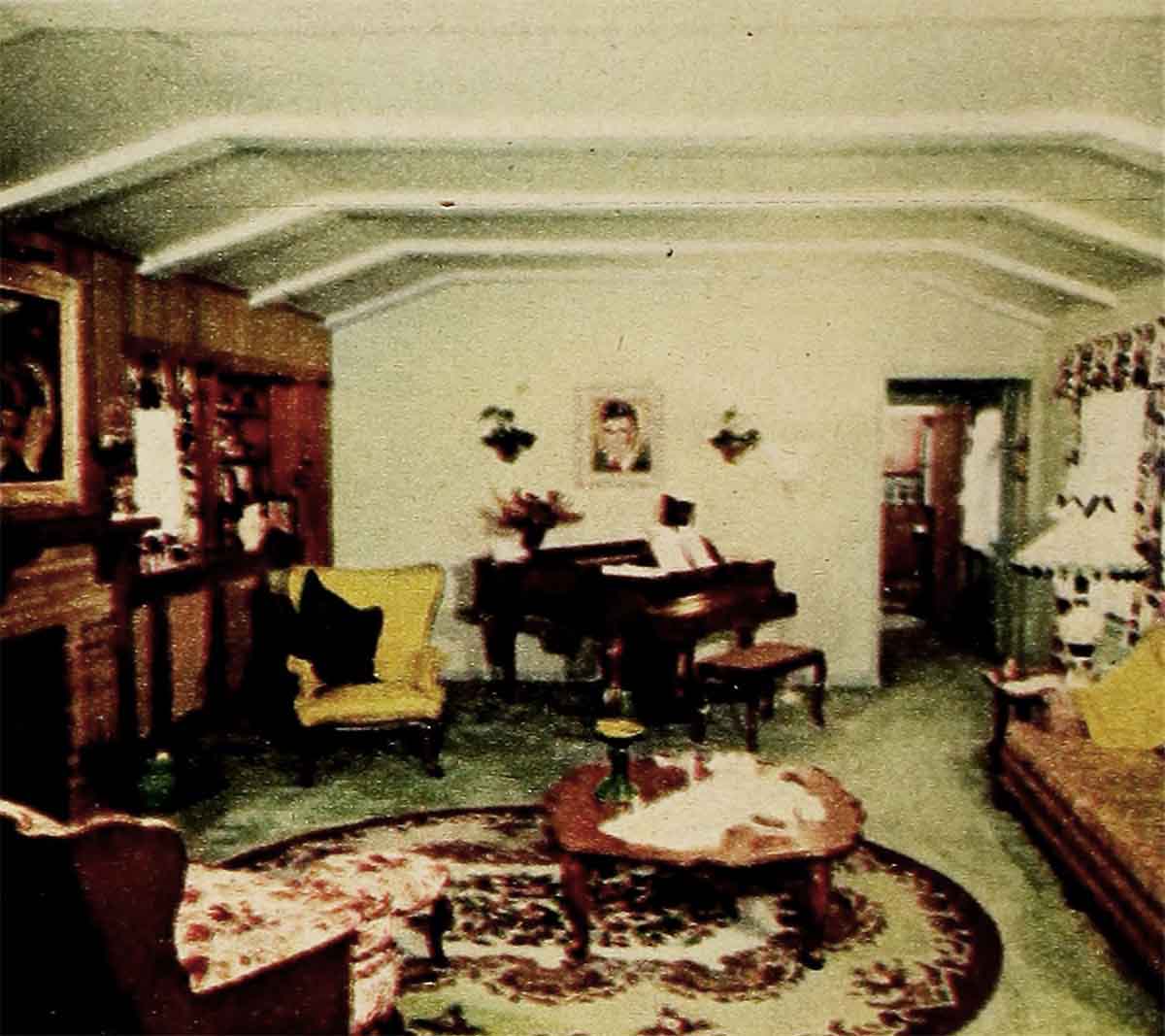
At the bookbinder’s Jerry picked up four large scrapbooks handsomely bound in expensive red leather. They contained photographs of their Honolulu Honeymoon #2, party pictures of son Gary’s last birthday, stills from Scared Sirf, and hundreds of newspaper clippings.
At the picture-framer’s there were 15 separate items-waiting for J. Lewis. All of his possessions are either bound or framed. This time he picked up his MODERN SCREEN achievement award, a cartoon of his recent knee operation, and a commendation from the Cerebral Palsy Foundation, among other pictures and certificates.
Having been raised in a period of post-war austerity coupled with typical British restraint, the English reporter was staggered by the morning’s shopping spree. “I say,” he timidly asked Jack Keller, Jerry’s press agent, “does this bloke carry on this way everywhere?”
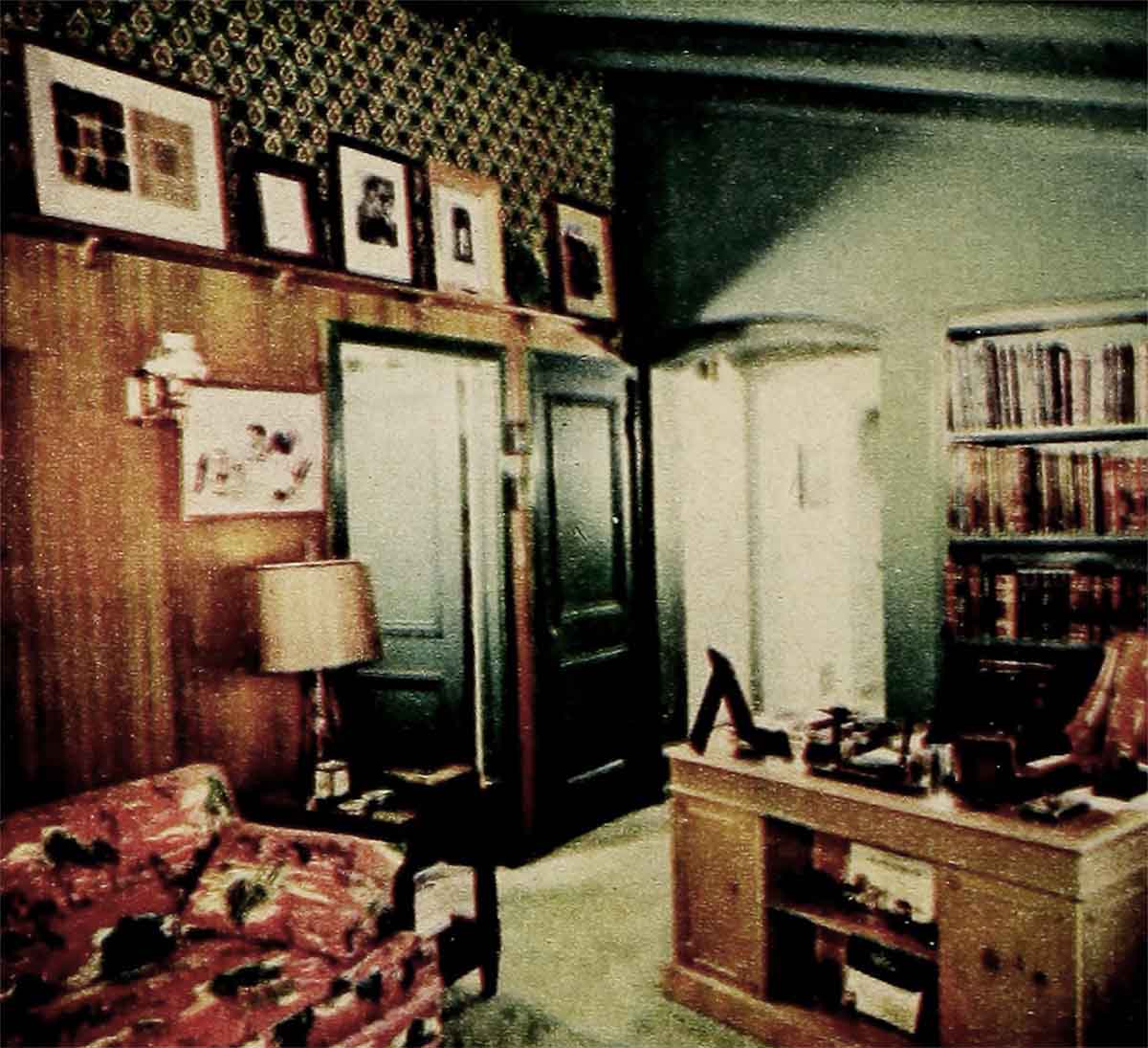
Keller was prepared with a ready answer. “In automobile agencies,” he explained, “he only buys one car at a time.”
“And how about his home?” the writer continued.
“About his home and home-life,” Jack said, “you’d better speak to his wife. She’s absolutely normal and no harm will come to you.”
Patti Lewis really enjoys keeping house for Jerry and their two sons, Gary, eight, and Ronnie, three and a half. The house, in turn, reflects and radiates this happiness.
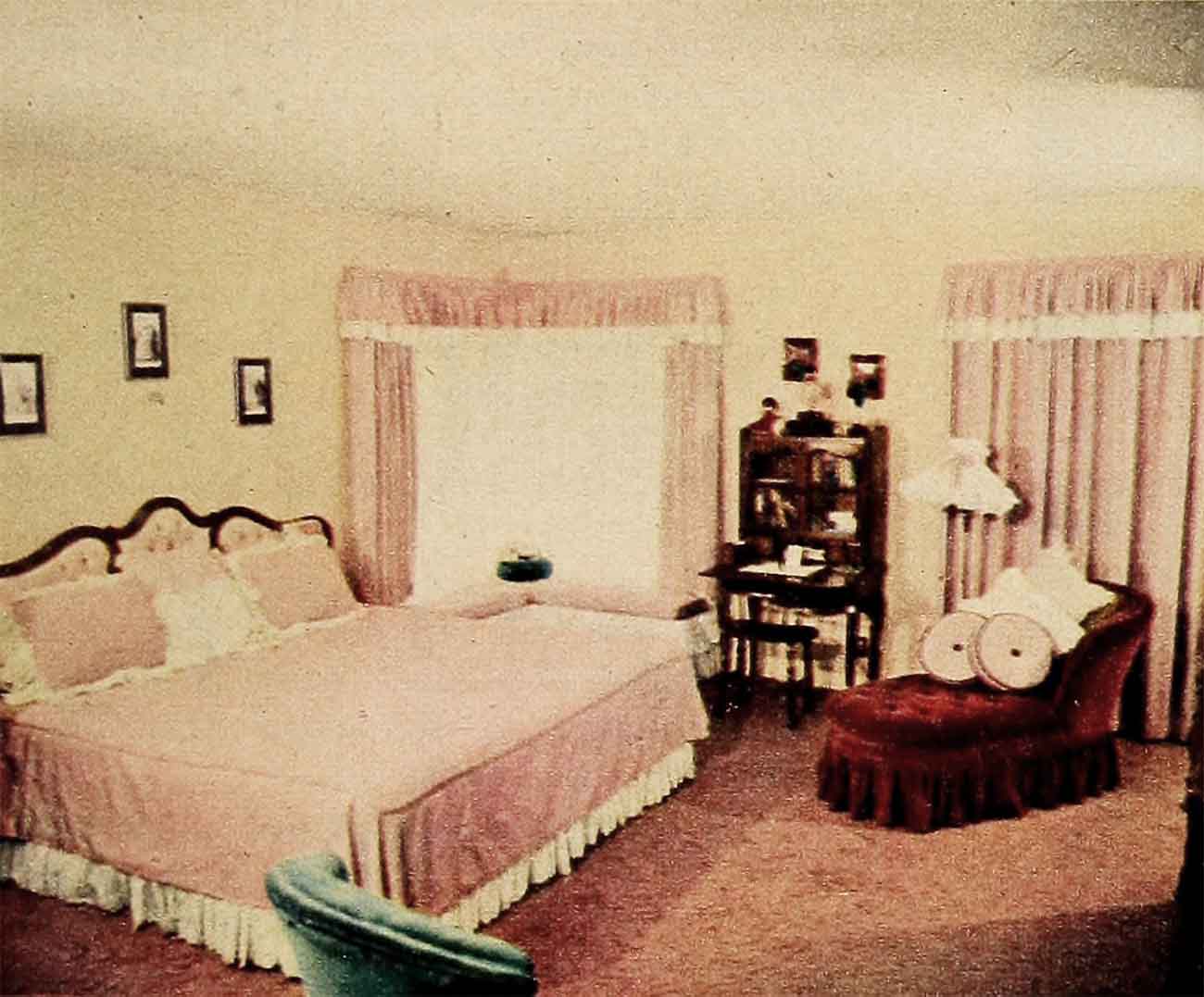
Five years ago come November, Jerry and Patti bought their home in the Pacific Palisades. They purchased it just as soon as they were certain that Martin and Lewis would be working steadily. “It’s the first real house either of us have ever known,” Patti points out. “As kids we lived in city apartments, I in Detroit, and Jerry in Jersey. Both of us left school pretty early to go into show business, and we were on the road a lot. That’s pretty tough living. You move from room to room and train to train, and you never have an acre of ground you can call your own.”
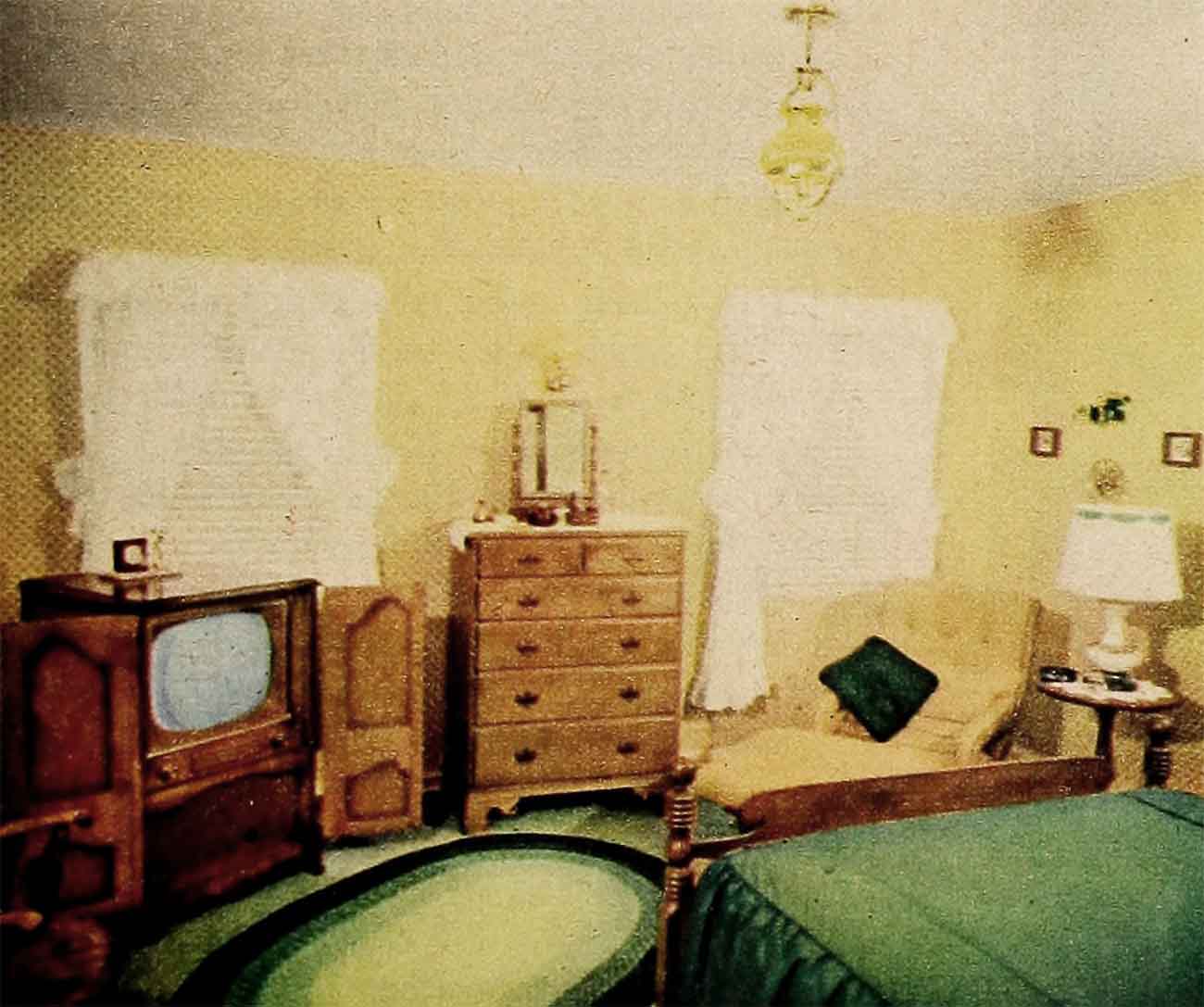
When Jerry and Patti first got married they used to spend non-working evenings perusing the various shelter magazines. “After Gary was born,” Patti recalls, “we really needed a house, and once the boys signed a contract with Hal Wallis, we started looking for one type of place, budget or no budget. We wanted the most completely House And Garden type of home we could find. And today, five years later, we still think we found it.”
The Jerry Lewis house is essentially the All-American dream home come true. Red brick, white trim, a picket fence, roses in the backyard, dogs yelping, a white gate, the whole works.
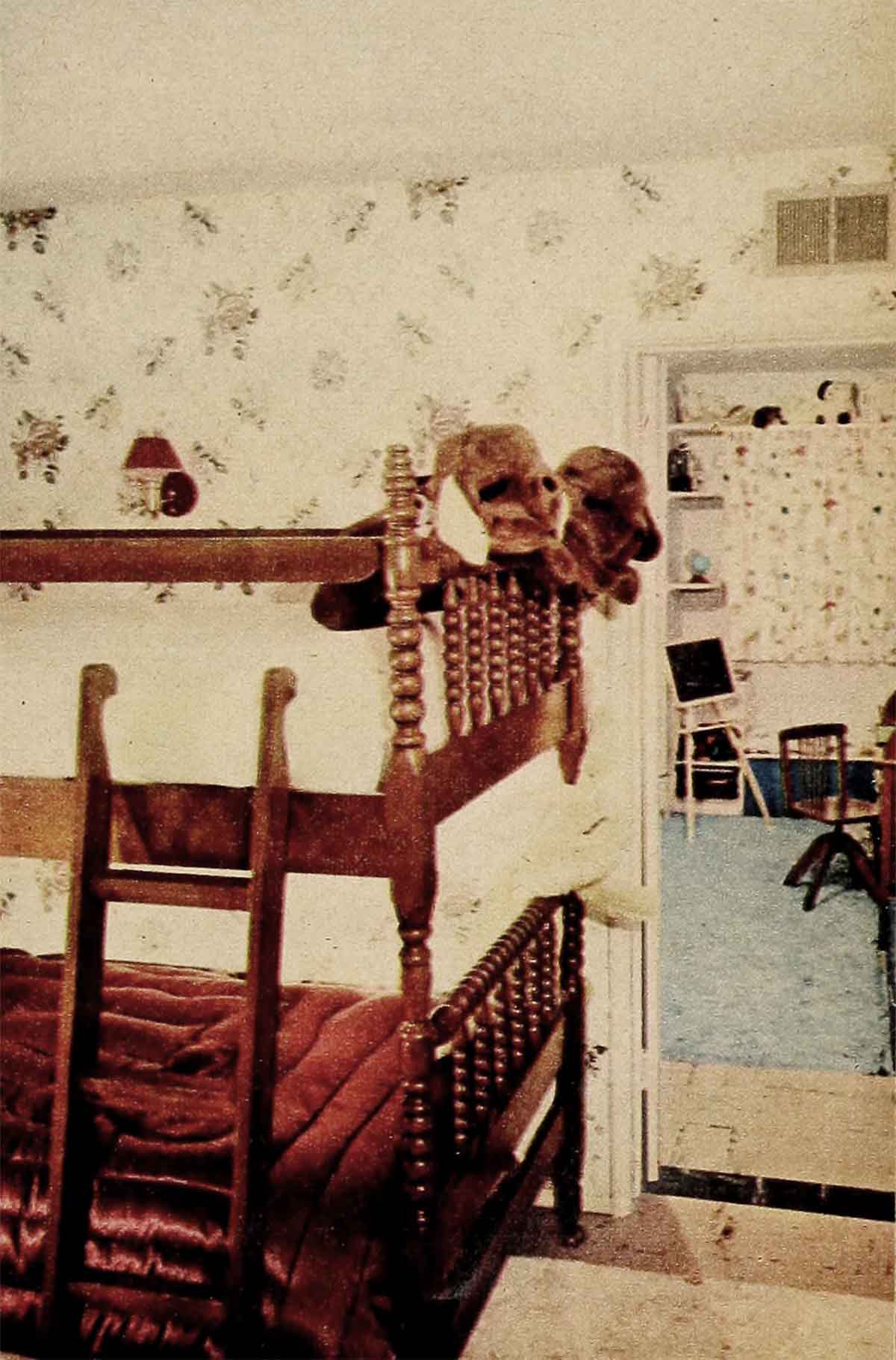
Wonderful to begin with, it still wouldn’t be genuine Lewis if it had been permitted to remain in its natural state. Jerry has a theory he applies to practically everything tangible: if you like something why not have a lot more of the same? This goes for golf clubs—at the last counting he had nine sets—guns, cameras, dogs, shirts, shoes, and jelly beans. And of course, houses.
Jerry liked his original structure so much that he decided to add a super deluxe playhouse a few yards away.
Originally the project started out to involve a small enlarging of the tool shed into a separate playroom for Gary and his kindergarten gang. Midway, Jerry took over the building supervision.
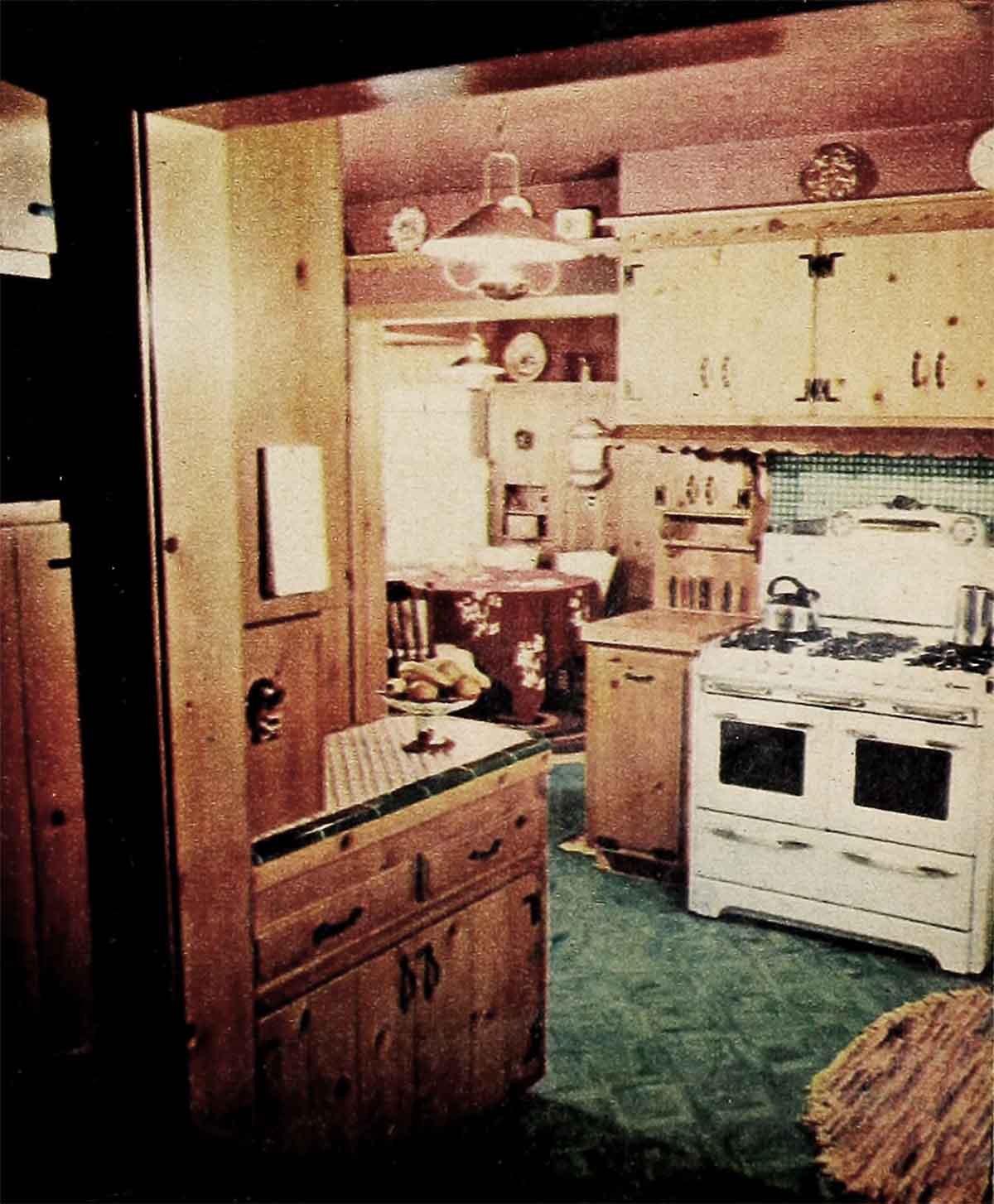
“This room,” he announced, “must have a barbecue. And if you’ve got a barbecue, you certainly need a refrigerator. Who wants to carry food from the kitchen all the time? But then if you can get ice cubes from your refrigerator, it’d be crazy not to figure on a small bar.” Even though Jerry drinks nothing but soda pop, a bar and apartment-size kitchen were added.
By the time construction got under way, Patti had accepted the fact that the building wasn’t going to be a rumpus room—at least not a rumpus room for children. When the costs approached the $25,000 mark, she called a halt. “Now, Jerry,” she stormed, “this whole thing has definitely got out of hand. You’ve got a fireplace, parquet floors, a four-machine projection room. If you don’t stop we’ll end up with something like Radio City.”
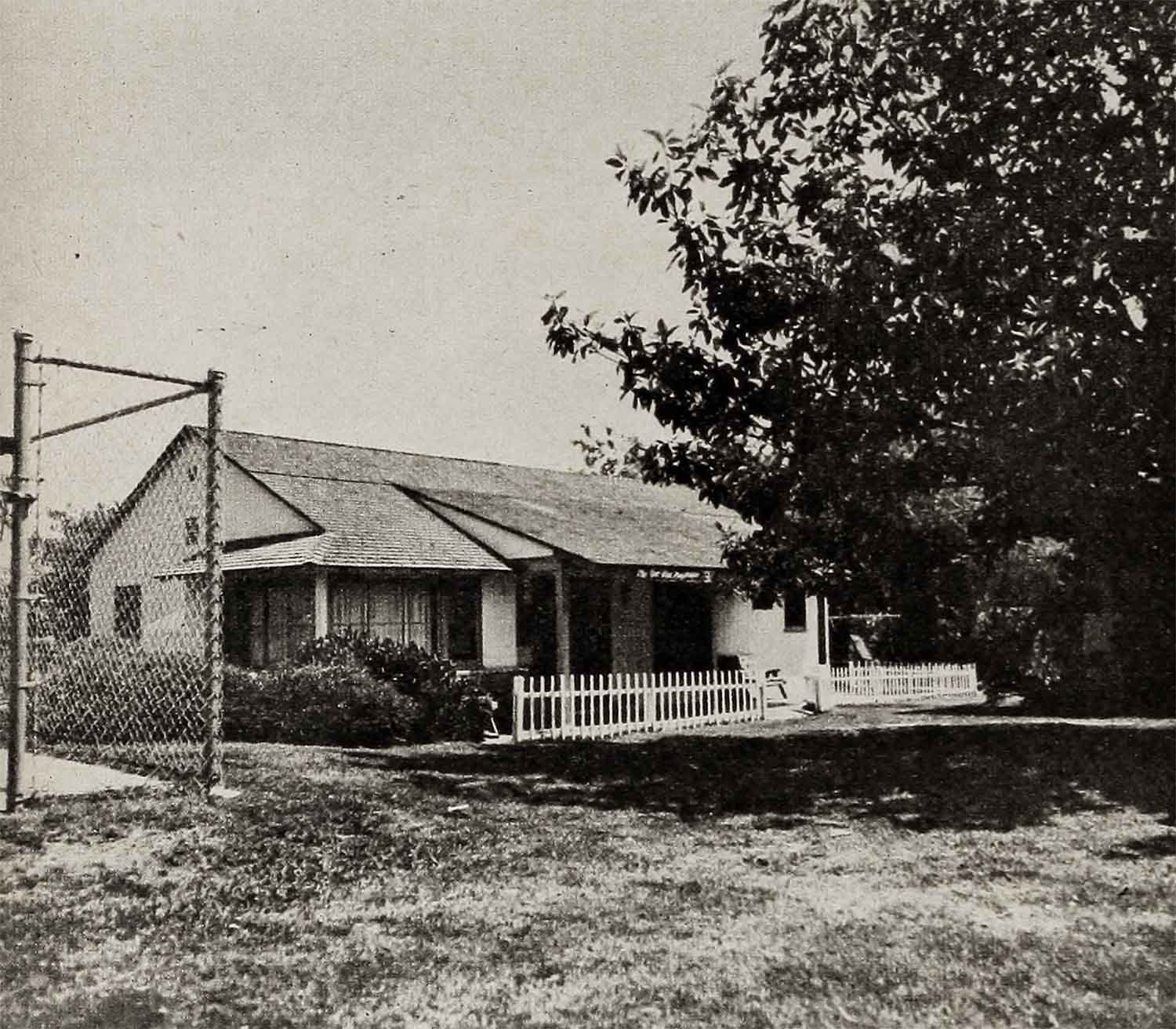
Jerry argued that having a playroom away from the main house was really very economical. “Just think,” he offered, “how much. wear and tear we’re saving by keeping people out of our living room.” He grinned. “Seriously, Patti,” he said, “we don’t go out very much, and I’ve always wanted a recreation room.” Jerry won his point—which is very easy to do with Patti since her heart is made of butter—and work on the playroom was resumed. Today, it is worth somewhere in the neighborhood of $80,000 which is twice what the Lewises paid for their original residence.
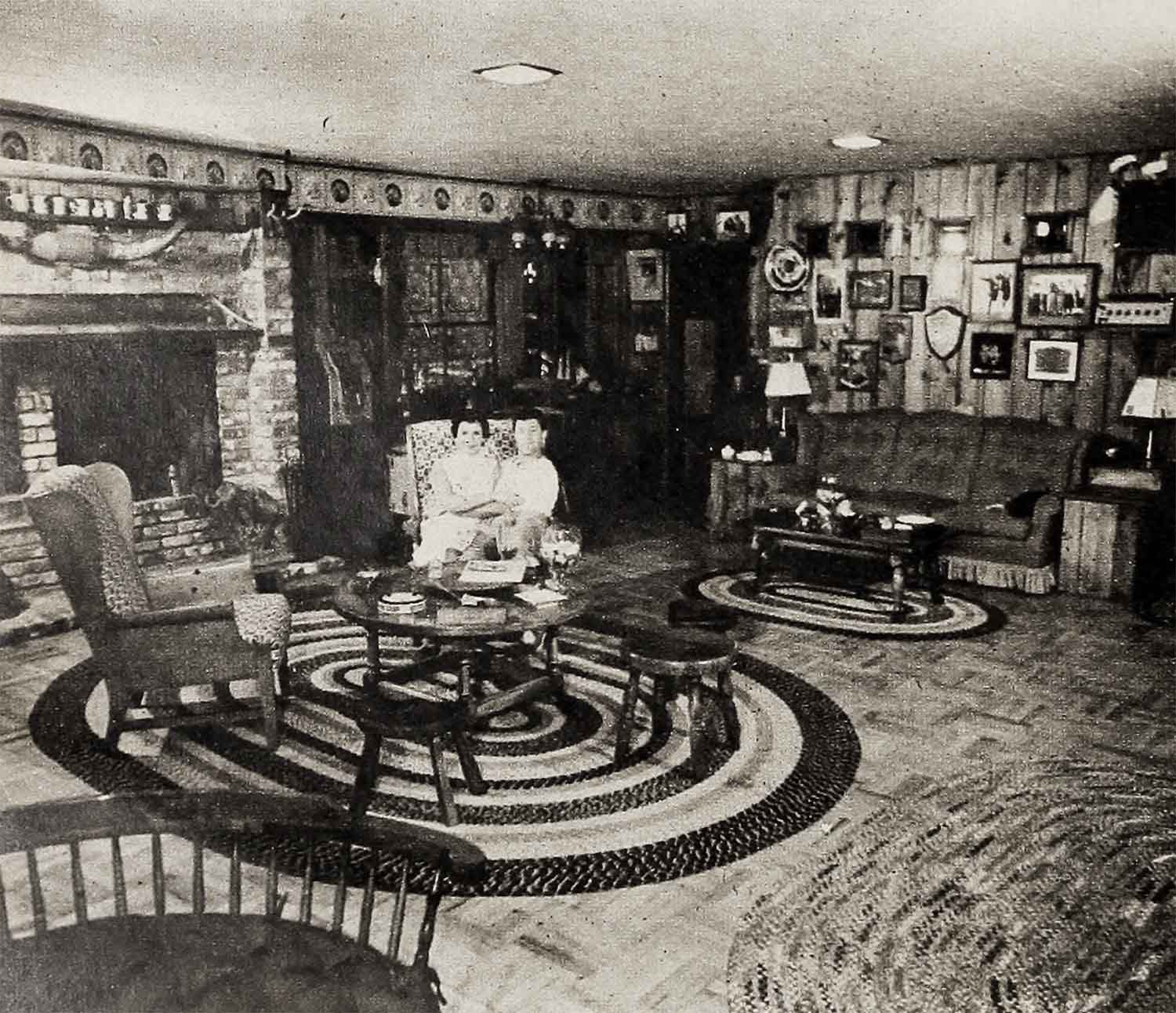
“That rumpus room,” Jerry says, “is worth every cent it cost.”
To satisfy her two sons, Patti bought a pre-fabricated playhouse and set it up alongside their father’s.
The result of all these additional structures was that they cut the size of the Lewis lawn. One morning Jerry awoke and looking out on his property, said, “You know, Patti, every family should have enough room to play a little pick-up baseball.”
“Yes, dear,” Patti mumbled, then promptly turned over on her side an returned to sleep.
Jerry, however, got dressed, went outside, and bought the vacant lot next door. He now uses. this for practicing chip shots.
The changes Jerry has wrought outside their home Patti has practically matched inside. Although she loved the basic plan of their U-shaped house, to begin with she realized that alterations would have to be made to suit their own particular needs. In the gabled living room, for example, she added window seats on one side of the fireplace and shelves on the other. The seats are for guests and the shelves are for Patti’s collection of porcelain dogs that she started when she was a little girl. Here, too, she hangs the show ribbons won by her two Springer spaniels, Chipper and Percy.
According to her mother, “Esther (Patti’s real name is Esther Callonico Lewis) is a pushover for children and dogs. She can’t ignore a child and she can’t go to the vet without bringing home a pup.”
All the colors throughout the Lewis home were chosen by Patti. Without leaning on a decorator’s arm, she simply made up her own mind as to furnishings. For the living room she chose a grey-green carpet that matches the wall and ceiling, The piano, coffee table, and lamp tables were ordered in pale mahogany. Then to give her room a logical center she placed a large, round, hooked rug in front of the fireplace. This, plus a bowl of Jerry’s bulk candy on a square table, helps to draw conversational groups together.
Two Christmases ago portraits of Jerry and Patti were added to the room via the coincidence route. It started with Hal Wallis’ approaching Patti and suggesting that Paul Clemens, the popular artist, paint her. Patti wert along for the sittings without telling Jerry. On Christmas Eve she placed the completed picture under the tree. It was wrapped in a suit box. Jerry’s gift to her looked like it might be a bass fiddle, “Just in case you want to start up your all-girls band again.”
Early next morning they opened the boxes. Patti fought her way through layers of paper and found herself looking at a bright oil painting of her laughing husband. “Oh, no,” she squealed. “But how did you ever guess what I had for you?”
Jerry howled. “I’m psychic.”
After remodeling her living room, Patti went after the children’s wing of the house. She added two small bedrooms so that each boy might have his own private realm with the nurse’s bedroom in between. Of late, however, the boys have decided to move in together. They begged their mother to buy double-decker bunks so they could sleep in one room but keep their toys in separate ones.
They also demanded that they be allowed to eat with their father. Patti broached the subject to Jerry, and he said, “Sure, let ’em eat with us.”
“But not in the dining room,” Patti protested. “They’ll ruin the rug.”
“Okay,” Jerry agreed, “we’ll all eat in the kitchen.” Which meant that-Patti had to make the kitchen larger. She ordered new appliances, a refrigerator and dishwasher, a giant freezer, and a six-burner stove. She moved all the laundry equipment outside to a lattice-enclosed porch, then bought a large oval table and tour well-cushioned chairs. In addition she had a niche built for a radio because Jerry likes music with his food. She also had the carpenters hang a magazine rack along one wall since the master of the house likes to read while he waits for his food. He likes to read a trade paper called Variety.
The formal dining room in the Lewis ménage is saved for guest night which is at least once a week. Jerry and Patti both love people, and when the group is small they serve a sit-down dinner by candlelight. Their favorite meals have a slight Italian flavor with a side dish of spaghetti or ravioli and Patti’s special fried chicken. She fries the chicken slowly in a skillet with onions, parsley, green peppers, and garlic. She makes a gravy with the left-over seasoning, and no one who has tasted this concoction has ever refused a second helping. Nor can anyone understand how Jerry can eat at home and still stay so thin. Actually he’s hypersensitive, hypernervous, and congenitally restless.
For her part, Patti does everything to make life at home serene for her husband. No comfort is too much for him. Only a few weeks ago she called in a cabinetmaker to construct a new dressing room for her boy. Jerry’s old wardrobe space wasn’t large enough to hold the tremendous amount of haberdashery he buys. Now an entire room has been assigned to that purpose.
Jerry and Patti have been so happy in their home that friends are constantly asking them for help in house-shopping.
“It’s not the house that counts,” Jerry recently told Janet and Tony Curtis. “It’s what you’ve got inside. Patti and me and the kids—heck, we’ve just got a lot of love for each other.”
And there’s where the Clown Prince of Nonsense has made the most sense of his life.
THE END
—BY MARVA PETERSON
(Martin and Lewis will be seen soon in Paramount’s The Caddy, a Hal Wallis Production.)
It is a quote. MODERN SCREEN MAGAZINE OCTOBER 1953




